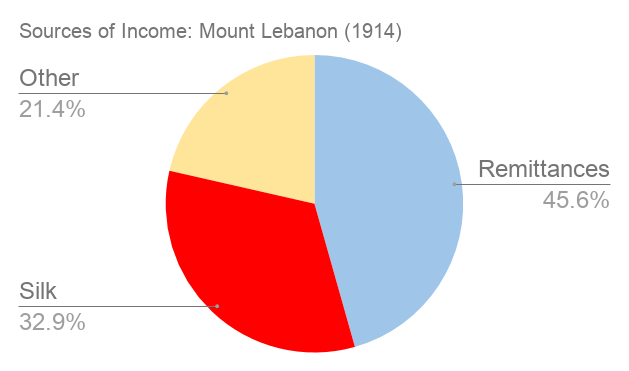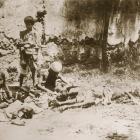
World War I map of proposed French colonies including Adana.
World War I map of proposed French colonies including Adana.
Unknown cartographer, 1919.
Courtesy of the Marseille Chamber of Commerce Archive.
 This work is licensed under a Creative Commons Public Domain Mark 1.0 License.
This work is licensed under a Creative Commons Public Domain Mark 1.0 License.
With a death rate in excess of one in three, Ottoman Mount Lebanon suffered higher per capita mortality than any other bounded territory during World War I. Hunger and related diseases decimated the civilian population of Beirut and Mount Lebanon, which lost around 200,000 persons. Despite the scale of this tragedy, the famine has been traditionally absent from accounts of the country’s history (with a few exceptions cited below). This article offers a systematic explanation for an event that recent scholarship has cast as multicausal. What distinguished Lebanon from the surrounding region—which suffered a much lower civilian wartime death rate—was the predominance of capitalist social relations. That fact dictated Mount Lebanon’s particular susceptibility to famine.
A dense population relied on the intensive cultivation of terraced mountainsides and a thin coastal strip. Peasants tended mulberry trees and purchased silkworm eggs on credit in the springtime. A portion of the labor force, primarily consisting of women, labored in factories where they processed cocoons into silk thread. Merchants based in Beirut and Lyon coordinated the investment of capital in the silk industry and the export of semi-processed cloth. The port in Beirut, which was the seat of its own province, mediated those exchanges. This system was geared for profit. Although overwhelmingly rural, the Lebanese imported the majority of their staple crops. The rural population had little recourse to a means of subsistence outside of capitalism.

Diagram by Graham Pitts, 2020.
 This work is licensed under a Creative Commons Attribution 4.0 International License.
This work is licensed under a Creative Commons Attribution 4.0 International License.
The war marked the culmination of a cycle of accumulation. During the first stage, peasants had gained land in the nineteenth century and some had enriched themselves by participating in the silk economy. The collapse of silk’s price in the 1870s and the financialization of the economy saw many lose their land and enter a cycle of indebtedness. Migration to the Americas, which began in the 1880s, represented a potential solution to precarity for laborers. Wages rose. Remittances from the Americas became the largest source of income by 1914. The centrality of capital to Lebanon’s agrarian life caused class differentiation which the crisis of World War I laid bare in brutal fashion.
When war broke out, the silk economy collapsed and left those who relied on it destitute. Land changed hands as those who had cash reserves took advantage of the growing food crisis. A group of influential merchants dominated the grain trade and moved wheat wherever they could find the highest prices. Meanwhile, the poorest rung of the rural and urban working class suffered first and foremost. Historical memory has all but totally obscured this class dimension of the crisis.
Interactive map of remittances in the Eastern Mediterranean. Graham Auman Pitts and Marjorie Stevens, 2019.
In Lebanon, the standard interpretation cited an intentional Ottoman government plot to starve Mount Lebanon, a countervailing explanation blamed the French blockade. Both versions give credence to a number of other factors such as bad weather, locusts, and profiteering. Elizabeth Thompson deserves credit for drawing attention to the famine’s significant historical importance in her influential Colonial Citizens (2000). Before her, Linda Schatowski-Schilcher authored a path-breaking article enumerating the many dimensions of the breakdown of the region’s food economy. Tylor Brand’s dissertation and subsequent work is equally indispensable to understanding the period. Melanie Tanielian has produced the first monograph devoted to the topic. Her book, along with an emergent generation of scholarship on the Ottoman Empire in World War I, casts the war as a crucial rupture with the past.

Survivors of the Famine. Specially authorized reproduction by Mrs. Nayla Kanaan Issa-el-Khoury.
Survivors of the Famine. Specially authorized reproduction by Mrs. Nayla Kanaan Issa-el-Khoury.
Photograph by Ibrahim Kanaan, n.d.
Courtesy of Emile Issa-el-Khoury and Nayla Kanaan Issa-el-Khoury.
Used by permission.
The copyright holder reserves, or holds for their own use, all the rights provided by copyright law, such as distribution, performance, and creation of derivative works.
Key questions remain: Did either the Ottoman or Entente governments intend to cause the famine? Should a basket of factors suffice as a sufficient explanation? Can one overarching interpretation account for the famine?
No party foresaw that the war would last long enough to cause a famine. Neither the Ottoman government nor France or Britain acted decisively to save Lebanon’s civilian population. Paris and London refused to allow aid through their blockade. Ottoman authorities, in conjunction with German advisers, continued to prosecute their war effort at the expense of their population’s welfare. The crisis was also an opportunity for Chambers of Commerce across France whose members lobbied for the colonization of the Eastern Mediterranean after the war. As the French government realized, a starving population would be obliged to accept any authority capable of alleviating the crisis. Superior environmental, and in particular agricultural resources, dictated the war’s outcome as Avner Offer has argued. While some may have benefitted, no actor possessed sufficient mastery over the complex relationships between humans and the rest of nature to plan the course of their interaction during the war.
Ultimately the logic of disaster obeyed, and revealed, the broader trajectory of Lebanon’s environmental history and its particular vulnerability to instability in the global capitalist system. It is perhaps imprecise to say that capitalism ‘caused’ the famine. The crisis happened because the interests of French industrial capital and the local bourgeoise dominated Lebanese social organization. In that regard, it was an exception in the rural Ottoman Empire. Lebanon’s tragedy can only be explained in regard to capitalism’s proclivity for producing crises in the human relationship with the rest of the environment.
How to cite
Pitts, Graham Auman. “Was Capitalism the Crisis? Mount Lebanon’s World War I Famine.” Environment & Society Portal, Arcadia (Spring 2021), no. 3. Rachel Carson Center for Environment and Society. doi:10.5282/rcc/8801.
ISSN 2199-3408
Environment & Society Portal, Arcadia
 This work is licensed under a Creative Commons Attribution 4.0 International License.
This work is licensed under a Creative Commons Attribution 4.0 International License.
2021 Graham Auman PItts
This refers only to the text and does not include any image rights.
Please click on an image to view its individual rights status.
Akın, Yiğit. When the War Came Home: the Ottomans' Great War and the Devastation of an Empire. Palo Alto, CA: Stanford University Press, 2018.
Brand, Aaron Tylor. "Lives Darkened by Calamity: Enduring the Famine of World War I in Lebanon and Western Syria." PhD dissertation, American University of Beirut, 2014.
Pitts, Graham Auman. “The Ecology of Migration: Remittances in World War I Mount Lebanon.” Arab Studies Journal 26, no. 2 (Fall 2018): 100–127.
Pitts, Graham Auman. “Make them Hated in All the Arab Countries’: France, Famine and the Making of Lebanon.” In Environmental Histories of World War I, edited by Richard P. Tucker, Tait Keller, J.R. McNeill, and Martin Schmid, 175–190. Cambridge, U.K.: Cambridge University Press, 2018.
Schilcher, Linda Schatkowski. “The Famine of 1915–1918 in Greater Syria." In Problems of the Middle East in Historical Perspective: Essays in Honour of Albert Hourani, edited by John P. Spagnolo and Albert Hourani, 234–54. Reading: Ithaca Press, 1996.
Tanielian, Melanie. The Charity of War: Famine, Humanitarian Aid, and World War I in the Middle East. Palo Alto, CA: Stanford University Press, 2018.
Thompson, Elizabeth. Colonial Citizens: Republican Rights, Paternal Privilege, and Gender in French Syria and Lebanon. New York: Columbia University Press, 2000.








